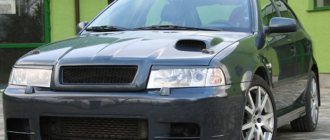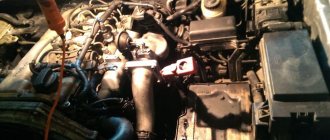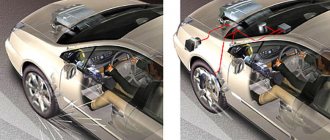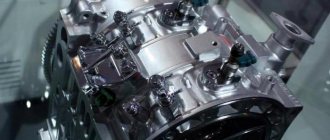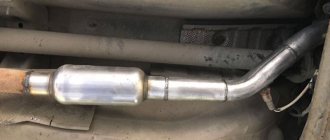Passenger cars have always had trunks, but there is a separate class of passenger cars where special attention is paid to this compartment. The demand for the ability to transport cargo without resorting to the services of relevant companies has given rise to the supply of cargo-passenger bodies that combine comfort and practicality. Naturally, as part of a compromise. This design is called a station wagon.
Hatchback
This body type is ideal for traveling around the city. The short wheelbase slightly reduces the turning radius and allows you to maneuver comfortably among other cars. The hatchback also takes up little parking space, which is important in a big city. The rear window is usually quite large, gives a good view into the rearview mirror and has its own wiper blade.
But the hatchback also has its disadvantages. First of all, the trunk volume is small. Of course, if there are one or two people in the car, then you can fold or remove the rear seat back, but four people in such a car cannot go into nature.
Another negative side is that the trunk is combined with the interior. Since the bottom of the trunk of almost all models is poorly soundproofed, the noise level in the cabin is quite high. In addition, hatchbacks are rarely equipped with large engines, so it is not very convenient for country trips.
Station wagon
Essentially, a station wagon is an extended hatchback with a longer wheelbase. Due to its length, it is less maneuverable, but has an impressive trunk size. Typically, this type of vehicle is used for transportation, so station wagons are often equipped with large displacement engines and diesel engines. That's probably where the positives end.
The station wagon's interior is quite noisy, for the same reason as the hatchback's interior. The rear window is located quite far from the driver, so visibility in the rearview mirror is reduced. Due to the fact that the rear part is high, when reversing it is constantly scratched by low tree branches. And parking in such a car is not very convenient. This car is suitable for those who rarely visit a big city; rather, it is convenient for country trips.
Sedan
The sedan's wheelbase is longer than that of the hatchback; in some models it is the same as that of the station wagon. The trunk is quite roomy, and given that the rear seatbacks can be folded or removed, it is quite suitable for transporting large items.
Another positive point is that the trunk is separated from the passenger compartment, so there is low noise level in the cabin. As a rule, sedans are equipped with the widest range of engines, ranging from small-volume gasoline engines to large-volume diesel engines.
One bad point is that the sedan does not have a wiper blade on the rear window. Also, the negative aspects of this type of body include the volume of the interior. As a rule, the distance between the rear and front seats is slightly smaller than that of a hatchback or station wagon. In principle, a sedan is a car that can be driven both around the city and outside the city; in its own way, it is universal.
13.06.2019
Many people who deal with cars wonder what the differences are between cars with different body types, such as an SUV and a crossover, a sedan or a hatchback.
For example, if you look at a BMW 6 Series Gran Coupe and try to determine what body type it belongs to, you can easily make a mistake. The difficulty is that this model looks like a typical sedan, but for some reason it belongs to the coupe class. Despite this, due to the wide variety in the modern automotive market, mistakes can occur even for people who are well versed in the world of cars.
What are the differences between different categories of cars?
Vehicles for off-road driving.
To be able to easily distinguish SUVs from crossovers, you should clarify on which platform a specific car model is created. Much attention should also be paid to the dimensions that each type of car has. The thing is that full-fledged SUVs have quite impressive dimensions.
According to the information contained in the international classification of SUVs, they are based on a frame platform, where the body is secured to a strong frame. Immediately after their appearance, all representatives of this class were made on a frame type chassis with a high level of ground clearance. After some time, thanks to the high popularity of this class of cars, cars were created in which the body was the load-bearing part and there was no frame. They are called crossovers.
Almost immediately after its creation, most cars of this class were equipped with an all-wheel drive system. Over time, in order to save money, all-wheel drive began to be connected using the AWD system, that is, with reduced interaction with the road surface.
Hatchbacks and station wagons.
Both cars belong to the universal category of automobile transport when compared with sedans or coupes. In fact, their technical characteristics are closer to the previous pair of cars.
The main difference between this class of cars and all others is the larger luggage compartment volume, which is achieved due to the ability to fold the rear seats. The second positive point is easier access to the luggage compartment than in sedans and coupes. Externally, these cars can be distinguished by the body kit on the rear side of the car, which is significantly different. Unlike hatchbacks, the station wagon body is slightly longer. Most often, the roof of a station wagon is as long as its rear edge. The rear overhang is designed to create more cargo storage space. In hatchbacks, it does not reach the rear edge of the car.
Sedans and coupes.
Previously, it was not particularly difficult to distinguish between sedan and coupe cars. A car with four doors was considered a sedan, and a car with two was considered a coupe. But, with the development of the car market, this principle ceased to apply, thanks to the advent of four-door coupes and two-door sedans.
For determining
Whether it’s a coupe or a sedan, just look at the car’s pillars from the side. Cars with a sedan body type have three support pillars, of which the middle one serves to support the doors. It is not available in coupe-type vehicles. Another difference from sedans is the closer location of the front seats to the rear of such a car.
There are also a small number of machines that do not fit into any of the above categories. These include, for example, a Nissan Murano.
Report a bug
Select it and press Ctrl + Enter
Thanks for the info!
Add a comment:
The bus, produced by the German company
Volkswagen 48 years ago, will be sold at the Bring a trailer auction.
The auction will take place online. Currently, the rare Volkswagen Bus is located in the United States. Its body is painted in two colors - white and light green. The wheels and both bumpers of this car are also painted white. The wheels have chrome caps. The wheels use tires from the famous manufacturer Hankook.
The interior of the minibus is equipped with passenger seats upholstered in fabric. The car has a CD player, which is not typical for the time the bus was built. It was probably installed much later. But the steering wheel of the car is original.
The power plant in this vehicle was a 1.6-liter engine, which has an air cooling system and works with a four-speed manual transmission. The bus has a rear-wheel drive mechanism. Currently, the starting price for this rarity is $12,000, which in Russian currency would be equal to 474,000 rubles. The mileage of this vehicle has not been announced. At the very least, there is no reliable information on this matter. Bidding will be announced in a few days.
The last stocks of several models of the American manufacturer Ford have run out in Russia.
The company announced back in the spring of this year that it did not want to continue operating in Russia, after which the brand’s enterprises were closed in two cities of the country at once.
But dealerships continued to sell new Focus, Fiesta, EcoSport cars. Now it has become known that stocks in car dealerships are running out and it is almost impossible to find them.
Dear Dmitry Anatolyevich! As a State Duma deputy from the Samara region, I am seriously concerned about the situation developing in the automotive industry, the largest manufacturer of passenger cars in Russia and Eastern Europe. I remember very well how VAZ and the city of Togliatti were built, and what significance they had and can still have for the country’s economy, since I worked my way up at the Volzhsky Automobile Plant from a foreman to the deputy head of the scientific and technical center. January 22, 2020 You visited AVTOVAZ. However, unfortunately, you were never shown either the destroyed Experimental Industrial Production and the Volzhsky Machine-Building Plant, or the queues for free lunch in which former employees of the bankrupt Avtovazagregat were forced to stand, or new lists for layoffs of several thousand more workers. Engineering was almost completely eliminated at the enterprise - there was a total reduction in the staff of the Scientific and Technical Center. This means that AVTOVAZ will no longer have its own domestic developments. The destroyed Volzhsky Machine-Building Plant provided a full cycle of high-precision products - there are only a few such enterprises throughout the world. The cessation of production by the plant of a large range of components and parts causes dependence on foreign suppliers among enterprises in the automotive industry, aircraft manufacturing, nuclear energy, and, most importantly, the military-industrial complex. In the future, there will be the liquidation of other Russian enterprises associated with AVTOVAZ, leading unique innovative developments, producing components, special vehicles for medicine, the Ministry of Emergency Situations and other emergency services. AVTOVAZ previously worked as a giant system: related enterprises - manufacturers of auto components and materials, as well as a whole network of research institutes - were involved in various areas of the automotive industry. Today all this has been destroyed. In the Samara region alone, over the last 10 years there have been over 200 enterprises and factories producing automotive components. Today there are only a few left. Problems began at AVTOVAZ back in 2005 with the arrival of the Moscow team. And the first mistake: they put managers in charge of the plant, among whom there were no specialists in the automotive industry. Twice the state poured in funds, but the money went into the sand. It all ended with the sale of a controlling stake to foreigners. I hope that today our Government understands that the transfer of control over AVTOVAZ OJSC to foreign owners - the Renault-Nissan alliance - was an extraordinary mistake that practically destroyed the domestic passenger car industry. It seems that the Russian Government simply refuses to notice that foreign owners are systematically working to eliminate AVTOVAZ as a competitor to foreign manufacturers. In fact, the Russian market is being cleared for foreign engineering products. The production of cars under the Lada brand is declining, while the assembly of Renault, Nissan and Datsun is actively gaining momentum. At the same time, the plant’s management actually ignores the import substitution program proclaimed by the President of Russia. Recently, AVTOVAZ President Bo Andersson
in his report
to V.V. Putin,
he loudly outlined the figure of 70% localization for Vesta, while taking into account hidden imports this figure is unlikely to reach 47%.
Almost two-thirds of the budget for the purchase of components and consulting is sent abroad to the accounts of foreign companies. And billions of debts remain to Russian parts manufacturers, domestic banks and suppliers. LADA Xray consists of approximately 80% foreign components, which makes it more expensive than many foreign cars. The decision of AVTOVAZ President Bo Andersson to move the production of Lada Vesta to Izhevsk not only cost the plant, according to open sources ,
an additional 10 billion rubles, but also significantly increased the cost of the model due to an additional logistics shoulder of 600 km. As a result, AVTOVAZ’s net losses in 2020 alone, according to the report, amounted to about 73 billion rubles. These are the biggest losses of the car plant in its history. As a result of your visit to Togliatti, the Russian automotive industry was promised 50 billion rubles of budget funds. A significant part of this money will presumably be used to support AVTOVAZ. And here a frightening paradox awaits us: this money will go to support the Renault-Nissan alliance, owned by the state that imposed sanctions on us! The foreign owner will continue to use our budget funds. It is important to understand that AVTOVAZ is not a separate enterprise. Today, this is the Russian passenger car industry itself, which is on the verge of destruction. In order to revive the domestic passenger car industry, it would be advisable for the Government of the Russian Federation to take radical measures. Now AVTOVAZ is practically bankrupt, with huge debts to Russian creditors. Taking advantage of this situation, the state could take away a controlling stake. In essence, it is necessary to return AVTOVAZ to Russia, i.e. nationalize the plant. This only requires political will. The automotive industry throughout the world is a driving force for the development of a huge number of related industries and the economy as a whole, with enormous employment (examples: Germany, Japan, USA, Korea, China). I would like to ask you to pay attention to measures that could radically solve the problems of restoring the domestic automobile industry:
Nationalization of JSC AVTOVAZ; — establishment of full state control over the activities of the enterprise; — selection of a responsible management team, especially the first person, from among experienced Russian personnel. In Togliatti there are a lot of competent VAZ managers who know well what the plant is, live in Togliatti, depend on the city and see its future future. - return of localization to a level of at least 90%, while eliminating hidden imports, which will provide an incentive for recovery domestic market; — maximum increase in duties on the import of imported cars and components from abroad;
State support in terms of recycling and preferential lending to stimulate demand among the population, including a temporary reduction (up to the abolition) of the transport tax on newly purchased cars under the LADA brand; — state support measures aimed at developing the export of AVTOVAZ products, including subsidizing logistics costs; — revival of the service and sales network system of JSC AVTOVAZ; — development of a program to support Russian manufacturers of automotive components and domestic small-scale production, including expanding access to credit, subsidizing the interest rate on loans to replenish working capital, increasing support through the industrial development fund; — it is necessary to focus the efforts of AVTOVAZ, the Government of the Russian Federation and regional governments on the preservation and development of traditional Russian suppliers, stimulating an increase in localization volumes in the Russian Federation, and implementing import substitution programs; — increasing the volume of government orders for JSC AVTOVAZ, placing the “Cortege” project at the pilot production facility of JSC AVTOVAZ; — creation in Tolyatti of a modern scientific and technological innovation complex for the development of new technologies for the Russian automotive industry (on the basis of Pilot Industrial Production, Volzhsky Machine-Building Plant, Scientific and Technical Center). The author is a deputy of the State Duma of the Federal Assembly of the Russian Federation, Secretary of the Central Committee of the Communist Party of the Russian Federation
When choosing a car, a person is guided by many factors, including the cost of the vehicle, the make, model of the car, and, of course, the body type. The last factor is almost decisive, because comfort and the possibility of proper operation of the car directly depend on it. Hatchback and station wagon are widely popular among drivers all over the world, and the difference between the two body types is what determines the motorist’s choice in favor of one option or another.
SUVs and Crossovers
If you want to quickly know how to distinguish SUVs from crossovers, then so that you don’t have any difficulties, you should know what platform this or that off-road model is based on, and also pay attention to the dimensions of the car body. The fact is that, as a rule, full-fledged SUVs have rather large dimensions. In fact, there are compact, full-fledged SUVs in the world, but, as a rule, there are not many of them. Most often, full-fledged SUVs have rather large overall dimensions.
Also, in accordance with the international classification of SUVs, they are based on a frame platform, where the car body is mounted on a strong frame. Initially, all SUVs were based on a frame chassis and had increased ground clearance. But due to the popularity of this class of cars, SUVs with a monocoque body structure (without a frame), which were called “crossovers,” began to appear on the market.
At the initial stage, many crossovers were also equipped with full-fledged all-wheel drive, which is equipped with real frame SUVs. But in order to save fuel and reduce production costs, many crossover automakers began to equip them with all-wheel drive (AWD). With this system, torque is transmitted to all four wheels only when traction decreases. That is, if necessary. Some vehicles can also enable all-wheel drive by activating a specific function.
But not all cars can rightfully be called crossovers. For example, on the modern market there are non-frame crossovers that, in terms of their technical characteristics, belong to SUVs, despite the lack of a frame chassis. After all, it’s not just the frame that says that the car is designed for heavy off-road use. The fact is that the ability of a car to pass difficult off-road areas depends on a number of many other important characteristics, parameters and technologies, ranging from the suspension design, the presence of a 4x4 drive, the axle locking differential, ground clearance, body overhang angles and ending with many other things . In general, as you already understand, there are several types of crossovers on the market: cars for the city and light off-road, and cars designed for both the city and real off-road use.
As a rule, ordinary inexpensive crossovers are created mainly for urban and suburban use on asphalt or, in extreme cases, for driving on light off-road conditions, in contrast to full-fledged SUVs and crossovers capable of driving through severe off-road conditions, which can conquer difficult terrain, thanks to full-fledged all-wheel drive 4x4, high ground clearance, body overhang angles, various off-road technologies, ranging from differential locks, etc.
An excellent example of a full-fledged SUV is the GMC Yukon Denali, which is based on the GMT K2XX platform. General Motors uses the same platform to produce the Chevrolet Tahoe, Chevrolet Suburban and Cadillac Escalade SUVs. The same platform is also used in the production of the Chevrolet Silverado and GMC Sierra SUVs.
Another example of a real Mercedes G-Class frame SUV, which has been produced by the German brand almost unchanged for a long time. But the same Mercedes ML-Class is based on a monocoque platform without the use of a frame chassis. And, despite a number of off-road technologies, the ML-class cannot be called a full-fledged SUV. After all, this is an ordinary off-road crossover. In principle, the same station wagon, only with increased ground clearance, capacity and all-wheel drive.
If a real SUV is, as a rule, larger than a crossover (in most cases, although there are full-fledged mini SUVs in the world), then generally crossovers are larger than their passenger counterparts. Why analogues?
The fact is that most modern crossovers are based on passenger car platforms. As we have already said, the body of crossovers is created, as a rule, from one solid supporting structure. Just like cars in any body. As a result, due to the lack of a heavy frame, crossovers are much lighter than their older brothers, SUVs. This allows automakers to achieve significant fuel savings. In combination with a plug-in AWD all-wheel drive system, modern crossovers can effectively save fuel for their owners, in fact not much different from conventional passenger cars.
It just so happened in recent years that crossovers also began to be called SUVs. Although this is wrong. But, unfortunately, this confusion in the classification of crossovers and SUVs cannot be stopped. All car companies are directly interested in this and deliberately cause confusion in the market. It is purely a marketing ploy to call crossovers SUVs.
Read more: EVA car mats reviews
Thus, automobile brands replace the concept among the classes of vehicles accepted throughout the world. This allows car companies to sell crossovers as SUVs. Have you noticed that most modern crossovers are advertised as full-fledged SUVs?
Watch a few videos advertising crossovers and you will get the impression that driving such a car you can even go where no one has gone before. Although in fact, the maximum crossovers are light off-road (with the exception of some crossovers that are actually adapted for non-light off-road).
Thus, car companies, taking advantage of the incredible popularity of crossovers, began to produce actual passenger cars with increased ground clearance and greater versatility, positioning them on the market as SUVs. Although in fact such cars are called crossovers, intended mainly for use on asphalt or light off-road.
In principle, automobile companies have found a way to sell us twice as expensive the same ordinary station wagon cars equipped with all-wheel drive.
Station wagon
(from Latin universalis -
“general”
) - a type of closed two-volume cargo-passenger body of a passenger car. It is a sedan version with an increased luggage compartment and an additional lifting door in the rear [1].
In this meaning, this term is used only in Russia and a number of neighboring countries (see also the section “International Terminology” below in the text).
Hatchback
The car body may have one or two rows of seats, depending on the configuration. A distinctive feature of this body type is the presence of a door in the rear wall and, most importantly, a shortened rear overhang. The last factor makes it easy to distinguish a hatchback by its appearance. As a result, the car's trunk is not as spacious as, say, a station wagon. But this design allows the hatchback to maneuver well in urban environments, which is why this body type is widely in demand in metropolitan areas. Another advantage is the possibility of easy parking. The actual combination of the passenger compartment and trunk also has a negative side: quite often, drivers and passengers complain about an unpleasant smell from the trunk if, for example, some products are transported there.
Toyota Prius NHW20 - hatchback example
What are the station wagon body types?
Utility bodies were created in different directions, focusing on maximum internal volume, comfort, design or sportiness. Therefore, several separate categories were identified within the class.
- A traditional station wagon, a car with a large, pronounced rear overhang, developed “aquarium” type glazing, a clear two-volume body, and an almost vertically located rear door.
In such models, not only lifting trunk lids can be used, but also double-leaf doors of vertical or horizontal orientation.
Station wagon
This is a closed two-volume body for passenger and cargo transportation. We can say that a station wagon is a sedan with an enlarged luggage compartment and an additional lift door at the rear. As a result, the vast majority of station wagons have five doors, less often - three. Since the luggage compartment and passenger compartment are combined, this creates a risk of injury to passengers due to the cargo being transported (for example, due to an accident). Therefore, in many countries around the world they use a special dividing net to properly protect passengers from force majeure situations.
Opel Astra H - an example of a station wagon
Comparison
The combination of luggage compartment and interior is the most striking example of the similarities between hatchback and station wagon. What is the difference between a hatchback and a station wagon? In the following:
- The size of the luggage compartment of a hatchback is smaller; accordingly, this type of body is less often used for cargo transportation. But the station wagon is specifically purchased by many companies as a vehicle for cargo transportation.
- The hatchback has a more elegant design (rear part of the body). The inclined door looks more beautiful than the strict vertical version of the station wagon. For example, many women prefer hatchbacks because of their aesthetic appearance.
- The station wagon is longer. It is difficult to say whether this is an advantage or a disadvantage - it all depends on the purpose for which the car is used. If for freight, then it is rather an advantage; if for a regular trip and transportation of passengers, then it is closer to a disadvantage.
- The driving comfort of a station wagon and a hatchback is almost the same, except that in some station wagons tall passengers in the rear seats feel more comfortable.
- As a rule, a station wagon costs more. For example, the station wagon body type of new Lada Priora or Kia pro cee'd cars costs more than a hatchback.
What is the difference between coupe, sedan, hatchback, station wagon, SUV and crossover cars.
Have you ever asked yourself what is the difference between SUVs and crossovers? Or what's the difference between hatchbacks and station wagons? For example, look at the BMW 6 Series Gran Coupe and try to answer the question of what body type this model belongs to. The problem is that this model looks like a sedan, but for some reason this car is classified as a coupe. Unfortunately, due to the diversity of the automotive market and the models presented on it, even a connoisseur of the auto world can feel overwhelmed by the confusion that arises. Let's try to find out what kind of car you actually own and how you can distinguish one class of vehicles from others.
Read more: Amplifier and subwoofer power
Let's start with the light car category, which is hard to confuse.
Conclusions website
- Luggage compartment size. The station wagon is more spacious.
- Different designs. The rear of the hatchback car is more elegant than that of the station wagon.
- In the length of the car (station wagon is longer).
- The station wagon is more comfortable for tall passengers in the rear seat.
- In most cases, the cost of a station wagon is higher.
The introduction of the body as a load-bearing part of a passenger car made it possible to significantly expand the number of body types. But among all the variety of body types, there are the most popular among car enthusiasts. The leader among the types of load-bearing part is the sedan, but lately the hatchback body has been a good competitor to it. Each of them has its own differences, as well as positive and negative sides. Let's try to figure out what the features of sedan and hatchback bodies are, as well as what their advantages and disadvantages are.
Volvo V90
Few station wagons are as stunning, tech-savvy and versatile as the exclusive Volvo V90. Unlike the Cross Country all-terrain version, the regular V90 is only available by special order. Both feature sleek exterior styling that embodies the best in exterior design, and a refined interior that includes Apple CarPlay and Android Auto functionality with Wi-Fi hotspot, all as standard.
The V90 has two engine options and all-wheel drive. It's sportier than the Cross Country, but the ride can be harsh on rough surfaces. We were able to fit eight carry-on bags behind its rear seat, but the best competing wagons have more cargo space.
Volvo-V90
Sedan
Classic hatchback and sedan
The main difference between the sedan is the three-volume layout, in which the structure is divided into three parts - the engine compartment, the passenger compartment and the luggage compartment. These parts are separated from each other by partitions, which makes each volume of the body separate from the other. As for the number of doorways, this type of body can have either two or four doors.
As the automotive industry developed, different versions of sedans were produced, with certain features in the body design. The main types of sedan bodies are:
Video: Which is better, a sedan or a hatchback?
The difference between a classic sedan is that the overall dimensions of the engine and luggage compartments are approximately the same. Over time, in order to reduce the parameters of the car, which were usually significant for the “classics,” the length of the luggage compartment began to be reduced, while increasing its height to compensate for the useful volume. Ultimately, this led to the formation of the wedge-shaped body shape that all modern sedans now have. There are a lot of representatives of classic sedans, since this body type is the most popular. Examples in the domestic automotive industry are all “classic” VAZ models (except for the VAZ-2102 and 2104 station wagons), VAZ-21099, 2110, 2115, and all Volga models.
Among foreign cars, representatives of sedans are Toyota Corolla, Mitsubishi Lancer, BMW 5th, 7th series. In general, sedan cars are produced by almost all automakers.
Mercedes-Benz CL-class hardtop
A feature of the hardtop body was the absence of central pillars in the interior compartment. If in the classic version the front and rear doors were separated by a pillar stretching from the floor to the roof, then it was removed from the hardtop. In this case, usually the doors did not have glass frames, or they were retractable along with the glass in the door. Cars with sedan-hardtop bodies have not found particular popularity, and now they are practically not produced. Prominent representatives of cars in this body are the Chevrolet Impala and Cadillac de Ville Hardtop.
It is noteworthy that two-door versions of “hardtops” are still found, but most of them are classified as “coupes”.
The “fastback” body differed from the “classic” and “hardtop” in that the third compartment, the trunk, was very weakly expressed in the silhouette of the car. This was achieved thanks to a very smooth transition from the roof of the car to the rear. At the same time, the luggage compartment, although it was separate, was externally integrated into the cabin. The representative of the car with this body is GAZ Pobeda.
In the modern automotive industry there is another type of body – “liftback”, which is a transitional model between a sedan and a hatchback. Its main difference is hidden in the fact that externally there is a pronounced luggage compartment, but the body itself is two-volume and the luggage compartment is located inside the cabin. Among modern cars produced in a liftback body, the Skoda Superb can be noted.
Among the positive qualities of sedan cars, the following are noted:
- more presentable and respectable appearance of the car;
- the presence of a separate trunk;
- faster heating of the interior in winter due to the small volume;
- better safety for passengers in a rear impact (the trunk acts as a buffer).
But there are also disadvantages, of which the most obvious are:
- worse vehicle maneuverability due to large dimensions;
- complicated parking due to a worse feeling of the car’s dimensions;
- limited luggage compartment volume;
- less body strength due to large rear overhang.
Video: Lesson 2 - types of cars, hatchback, sedan, station wagon, body types, SUV, crossover, SUV
Peculiarities
“Common” bodies are divided into subgroups because they have differences. For example, there are models that have a flat roof; you can also find an option with a sloping roof. The station wagon has an excellent feature - the transformation of some seats, except the front ones. This will help if you need to load the trunk to the maximum. The salon can have 2-4 rows of seats. Some models with 4 seats are represented by a second line of seats, which “looks” in the opposite direction or is located lengthwise. Most cars with this body are equipped with a special rear door design that opens sideways or upwards. The American station wagon has a top and bottom lid that open independently of each other. Some models of Moskvich and GAZ may be Russian analogues.
Hatchback
Mazda3 hatchback
Let's move on to hatchbacks. Its main distinguishing feature comes down to a two-volume layout, that is, there is only an engine compartment and an interior. Moreover, the latter combines both space for passengers and luggage compartment. While the sedan uses a special lid to access the trunk, the hatchback is equipped with an additional rear door. At the same time, it is generally accepted that hatchbacks include only cars with a sloping rear door. But there are also versions with a vertical rear door (VAZ Oka, Daewoo Matiz). Due to the presence of an additional door in the design, the total number of doors in hatchback cars is unpaired (3 or 5 doors).
This body layout made it possible to reduce the rear overhang and, as a result, the dimensions of the car itself. Moreover, it is the overhang that allows you to visually determine what type of body it is. For example, one of the main differences between a hatchback and a station wagon is the size of the rear overhang.
A type of hatchback is a liftback. The main difference between a liftback and a hatchback is the same length of the overhang; in the former it is slightly longer. Additionally, on some liftbacks the luggage compartment may be slightly pronounced, which visually gives such a car the appearance of a sedan, but with a shortened trunk. And here the main difference from the sedan is the rear door. For liftbacks it is solid and includes the rear window. An example of such a liftback is the ZAZ Slavuta, in which the rear of the car visually has a trunk, but it is closed by a stepped rear door. The already mentioned Skoda Superb on some generations uses a two-section rear door - you can open only the part of the door that covers the trunk, or you can completely lift the door, along with the glass.
The advantages of hatchbacks are:
- the presence of sporty notes in appearance;
- easy access to the trunk due to the large dimensions of the rear door;
- the ability to transport large cargo (after folding the rear row of seats, which allows you to use part of the cabin as a luggage compartment);
- improved vehicle maneuverability due to smaller overall dimensions.
But this type of body also has quite a few disadvantages:
- increased noise in the cabin (can be caused by a shelf separating the luggage compartment from the cabin, a massive rear door, the cargo itself, since it is essentially located in the cabin and is separated only by the back of the rear seat and the shelf);
- when opening the rear door to the cargo compartment, air from outside enters the cabin (this disadvantage is especially evident in winter);
- the need for more time to warm up the interior due to its increased size).
Representatives of hatchbacks are Toyota Yaris, Seat Leon, Nissan Micra, etc.
As you can see, each of the considered types of passenger car body has its own positive qualities and negative properties. When purchasing a car, everyone decides for themselves which car suits them best.
Hello, dear readers of the blog Kak-Kupit-Auto.ru
.
Today we will discuss such a parameter for choosing a car as body type
.
Indeed, the type of car body
is one of the most important parameters when choosing a car, so let's figure out what you need to know when choosing
a car body
.
When choosing the type of passenger body
, you need to take into account the purposes for which the car will be used, in what conditions it will operate and what tasks you will set for it in the first place.
So what types of car bodies
?
Friends!
You all probably know that
a galvanized
car
is more resistant to corrosion
(practically does not rust).
Thanks to this, a car with a galvanized body
will be easier to sell at a high price
in the future - the car will lose value more slowly.
Most modern auto manufacturers use galvanizing of the body, but these technologies are different and do not always provide good protection. I recommend that before buying a car
, check whether the body of this model is galvanized and what galvanizing technology is used.
Types of passenger car bodies
There are quite a few, but now, in figuring out
which body to choose
, we will list only the most common
types of car bodies
.
An article about sedans and hatchbacks - which car body to choose: advantages and disadvantages, selection criteria. At the end of the article there is a video about which is better - a sedan or a hatchback.
- Classic of the genre - sedan
- Hatchback - a way for the young!
- Video about which is better - a sedan or a hatchback
The answer to this question will be the following question - “Who are you interested in?”, because the debate between domestic drivers about which is better, a sedan or a hatchback, began from the moment the first configuration of the VAZ 2108 hit the roads.
In the CIS countries, of course, sedans are in the lead - it is for these countries that many foreign manufacturers create new modifications in exactly this body style, which are practically not bought in Europe and the USA.
But hatchbacks are confidently conquering the market and taking away a significant piece of the pie from the classic configuration. Sales of sedans in the Russian Federation are in first place - this is approximately 32% of the entire market, hatchbacks have up to 25%, slightly inferior to SUVs.
Experts predict that the compact version of city hatchbacks could become the best-selling car in five years.
New drivers really struggle with which car to choose. Let's consider the main differences between body structures, their advantages and possible disadvantages.
History [edit | edit code]
In the pre-war years, station wagons were relatively rare, highly specialized utility vehicles, mainly used by small businessmen. Most of them were not assembled on an assembly line, but by small firms that widely used wood in body construction. Impractical wood bodies fell out of fashion in the 1950s, but in North America there is still a tradition of wood trim on the side of station wagons (and minivans) (the Woodie style).
The first all-metal station wagons were introduced almost simultaneously by Wyllis and Plymouth in the late 1940s, marking the beginning of the era of mass production of cars with this body type.
Read more: 10 Best Cars in the World
A surge in the popularity of station wagons occurred in the 1950s in North America due to the active development of suburbs (suburbania), whose population required fairly spacious, but at the same time respectable transport. As a result, the second half of the 1950s and the entire period until the end of the 1970s became the heyday of American full-size station wagons. It was during this period that such exotic options as hardtop station wagons without a B-pillar, two/three-door “sports” station wagons, station wagons with 4 rows of seats on a truck chassis, all sorts of variations in interior layouts, rear door designs, and so on appeared. At the end of the fifties, station wagons of various types accounted for more than half of the production program of such relatively budget American brands as Plymouth.
Meanwhile, the gasoline crises of 1973 and 1980, as well as the appearance in 1984 of the first American minivans - the Dodge Caravan and Plymouth Voyager models - and the fashion for large comfortable SUVs put an end to the dominance of large American station wagons. American fuel economy legislation introduced after 1975 (Corporate Average Fuel Economy - CAFE) established different emissions and fuel consumption standards for different classes of cars, exceeding which led to fines for the manufacturing companies. To bypass it, minivans were certified as light trucks.
, which made their production much more profitable than passenger station wagons of the same capacity.
As a result, if in 1979 light trucks
(including minivans and jeeps) accounted for only 9.7% of sales, by the early 2000s the share of this category of vehicles in the US market approached 50%, while station wagons practically ceased to be produced. True, in recent years in America there has been a definite tendency towards the revival of this class of cars, but primarily as fashion vehicles rather than utilitarian vehicles.
In Europe, station wagons throughout the post-war period retained their relatively modest but stable popularity as a family and cargo-passenger commercial vehicle.
In the USSR, a station wagon was perceived mainly as a cargo vehicle, and only then as a passenger car. Most of them worked in the national economy, in particular in the trading system and taxi service. This approach largely continues in modern Russia, where station wagons often do the work of a commercial delivery vehicle rather than a family vehicle.
Previously, station wagons were often used as a base for emergency vehicles. This practice could only be seen relatively recently in Russia, where Volga station wagons worked in ambulances. However, modern standards in most cases allow the use for this purpose of vehicles with a minimum interior volume of no less than a minibus. Therefore, the body of an ambulance based on a passenger station wagon has to be subjected to very significant alterations, including raising the level of the roof, which in most cases makes their use economically unprofitable.
It should be noted that the bodies of many modern SUV cars essentially belong to the station wagon type in their configuration, but in current practice they are usually classified as a separate category.
Classic of the genre - sedan
A sedan is comfortable, practical and stylish. The external shape of the body and the interesting design of the radiator grilles make the car presentable and expensive. This is the version in which all premium-segment cars are produced. The traditional sedan body consists of three distinct volumes: the interior, the luggage compartment and the hood volume. The trunk is always isolated from the passenger compartment.
The sedan is equipped with one or two (less often three) rows of seats; there is no lifting door in the trunk.
- Hardtop. A distinctive feature is the absence of central pillars, side windows without external frames.
- Fastback. A car with a sloping roof and a vaguely defined third luggage compartment.
- Tudor. Two-door sedan. The Chevrolet Monte Carlo can be considered the most prominent representative of the two-door sedan family.
- Long sedan. Today this is a very rare configuration - the car interior has three rows of full-size seats.
A transitional model, which is placed as an intermediate between a sedan and a hatchback, is a liftback. In terms of body shape, the car has overhangs similar to those of a hatchback, but the length of the luggage compartment is the same as in the sedan configuration.
Advantages of sedans
In addition to their representative appearance, sedans have a number of advantages that experienced drivers value so much:
- The sedan provides better weight distribution. This means that at highway speeds the car has ideal stability - it is easier to control and maneuver. The front and rear axles experience almost equal load due to the same volume of the engine and luggage compartment.
- Large and comfortable salon. Adult rear seat passengers notice this clearly.
- The interior is completely isolated from the trunk - this ensures silence and the absence of foreign odors.
- Greater parameter of passive safety of passengers. In the event of an accident, the trunk serves as a buffer.
- In winter, the sedan's interior warms up faster and cools faster in summer - this leads to fuel savings.
But are there any disadvantages to a sedan body style, and is it always beneficial to buy a traditional and familiar model?
Disadvantages of a sedan
- 70% of produced sedans have an average ground clearance of about 155 mm. This clearance will not allow the car to move on relatively easy off-road conditions. Leaving a snowy parking lot is often a problem for sedans. There are always exceptions - the first generation Skoda Octavia has a ground clearance of 170 mm.
- It is more difficult for novice drivers to park in sedans. Large cars require, albeit small, driving experience. Given the city's crowded parking lots and roads, it is more difficult for drivers to find a place to park.
- The cost of a sedan package is 10-15% higher than a hatchback of the same model.
- The rather large trunk volume of a sedan will not allow you to transport long loads (panels, baseboards, refrigerator, etc.).
But all these shortcomings are not perceived by connoisseurs of sedans as a big disadvantage of the configuration. Many drivers over forty have a love for this car almost at the genetic level.
Hatchback - a way for the young!
A hatchback (literally “rear hatch”) is a car with a shortened rear overhang, a door, often with two, less often with one row of seats. The main distinguishing feature of the configuration remains the length of the rear part, which is always less than the length of the front. If it is equal to the front, the car cannot formally be classified as a hatchback, even if it has similar shapes.
For example, the Audi 100 in the Avant modification, although the body is externally similar to a hatchback, has a rear overhang length equal to the length of the front one and belongs to the station wagon class. But the Ford Scorpio Mk has a three-volume (classic sedan) body, a pillar in the center to support the roof, but the length of the rear overhang is slightly shorter than the front - the equipment belongs to the Hatchback class.
Advantages of hatchbacks
The main advantage of hatchbacks is considered to be better maneuverability in city traffic due to their smaller size than sedans. What other advantages does the configuration have:
- Lower cost. Hatchbacks are more affordable than sedans and remain mostly budget models.
- The spacious trunk allows you to transport large cargo - if you fold the rear seats, the usable volume increases by 3-4 times.
- Smaller sizes will make parking in the city more convenient.
Hatchbacks are often chosen by young drivers who consider this model to be the most convenient for beginners, despite the fact that hatchback drivers have worse visibility through the rear window than sedan drivers.
Disadvantages of hatchbacks
What disadvantages do this configuration have, and are they so critical for choosing?
- Less comfort for rear row passengers due to the trunk combined with the interior.
- It takes more time to heat the interior in winter and to cool it in summer. Due to this, fuel consumption increases.
- Rear windows require the installation of a windshield wiper and washer.
- Less passive safety when hitting the trunk.
The sedan and hatchback are excellent examples of modern body modification that shouldn't even be a point of contention. You need to choose a model based on the personal preferences of the drivers.
Hatchbacks are an excellent family option; they are good for driving to work and getting out into nature. In addition, there are some models of popular cars that are produced only in a hatchback body - for example, Mercedes-Benz class A, Mazda 2, Fiat Bravo, Grande Punto, VAZ 2191, 1111, etc.
Video about which is better - a sedan or a hatchback:
Ravon model range
Along with sedans, Ravon produces subcompact five-door hatchbacks. These include Ravon R2 and Matiz.
Despite their similar compact dimensions, it is impossible to say that the machines are the same. They differ in technical characteristics, design and consumer audience. If we talk about the latter, then the Matiz is a car that has no equal in the segment of small practical cars. They are distinguished by their small size, ease of operation, stylish design and a wide palette of possible color solutions. By the way, ease of control is ensured by a manual gearbox. Don't let this bother you - it is more reliable and faster than many machines.
R2 is not tied to gender characteristics. Its driver can be either a woman or a man. At the same time, it is larger than Matiz and more powerful in technical parameters. The same goes for the trunk. With a small starting volume (only 170 liters), if you fold the rear backrests, you get 568 liters of useful volume.
The appearance of the Ravon R2 is recognizable: a massive radiator grille, slightly elongated eyes (headlights). The exterior of the car is stylish and attractive; it does not look small on the road, although its dimensions are considered quite compact. Even in the basic configuration, the car is equipped with two airbags, anti-lock braking system, electric power steering and other useful safety and comfort elements. This five-door car would be an excellent purchase as a family vehicle, an individual vehicle, or a special occasion gift.
Choose what meets your ideas about comfort and safety. If it is one of the Ravon brand cars, we are sure that you will not regret your choice.

